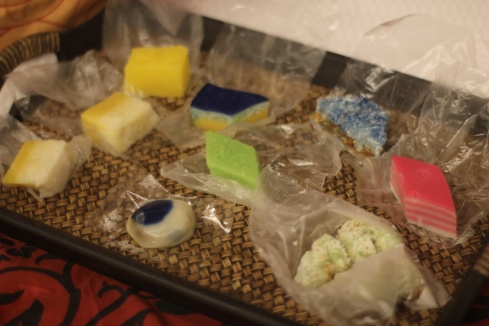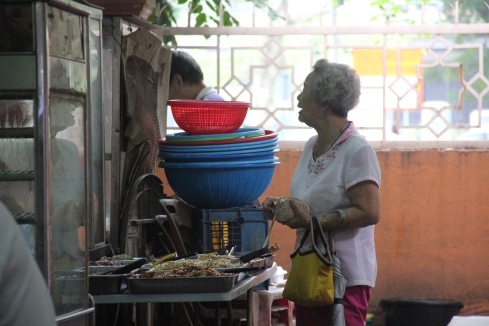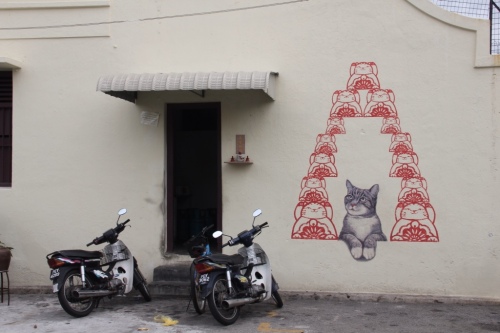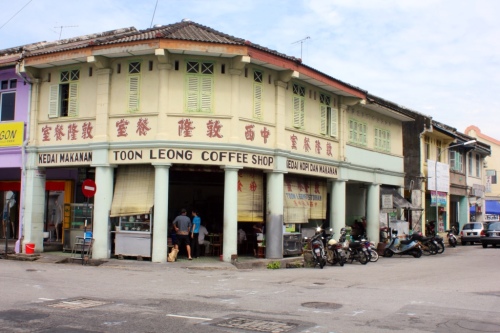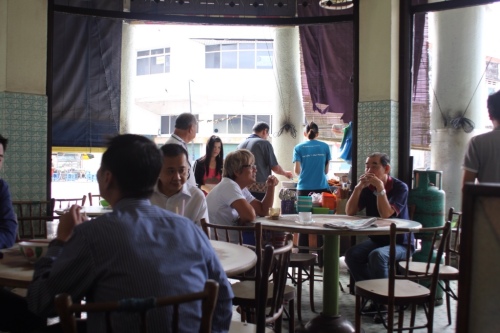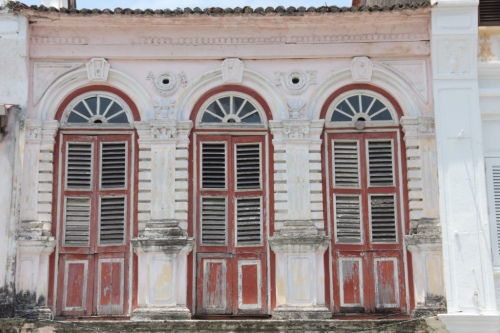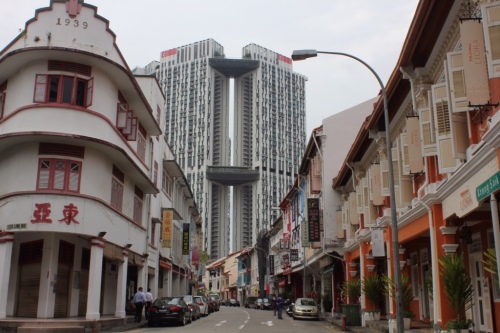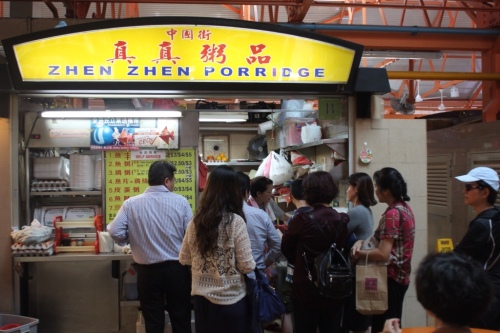You are currently browsing the category archive for the ‘Malaysian food’ category.
I don’t usually have a particularly sweet tooth, and I also tend to find Asian desserts to be a bit ho-hum. But Singapore and Malaysia may have changed those opinions forever, because the world of kueh has opened up for me. It all started in Singapore, where Kenny suggested that we buy some little cakes right after our massive blow-out meal at Chomp Chomp. We laughed, because really we couldn’t have eaten a wafer thin mint at that point. But Kenny insisted that we take some back to our hotel, so we bought two tiny, jewel-like green cakes. And sure enough, an hour later, in our hotel room, we thought why not, they’re very small…They proved to be absolutely delicious morsels, combining sweet sticky rice, coconut custard and pandan layers. When I reported this back to Kenny, he said that Singaporeans have a finely-tuned sense of when the human body will be ready to ingest just a little more food. Read the rest of this entry »
We arrived in Kuala Lumpur at kind of a bad time: it was Hari Raya, the end of Ramadan and a major public holiday in Malaysia. Muslims from KL typically visit their families in the north at this time, and because the holiday fell on a Thursday-Friday, everyone basically had a four-day weekend. The city was eerily empty in some places, jam-packed and business-as-usual in others. This probably contributed to our slightly off-kilter experience, but I think regardless of holidays, KL is not a city you fall for at first sight. Much of the centre is clearly not designed for pedestrians, and we found ourselves walking awkwardly along the edge of highways and under bridges. The public transit system looks great on paper, but all of the lines are owned by different companies and they barely intersect. Making a journey that includes a change of line most often includes leaving the station, walking a few blocks up alleys and across construction sites, then entering a new station and paying for another ticket. Luxury hotels and malls are being thrown up everywhere you look, but nothing fits together logically. It’s the very model of unchecked development. What to do to get our bearings in a strange Asian city? Obviously – morning markets!
The Lemurs spent the holiday season home in Glasgow and while it’s nice to relax in the bosom of one’s family, it’s also really important to me to get out and spend some time in the city. We were en route to a festive party but wanted to have dinner first – we anticipated a long and alcohol-fueled night and didn’t want to drink on empty stomachs. Sadly, we failed to realise that our host was making vast piles of delicious food, so we ended up eating twice, but that’s another story. We fancied Malaysian food and we’ve eaten at both formica-tabled Rumours Kopitiam (famously rude staff but good roti canai and laksa) and the slightly classier Asia Style (good, but tones down the Malaysian flavours). Neither were quite what we wanted, but I discovered that a new Malaysian restaurant has opened in the last year or so, called Banana Leaf. It’s been getting good notices online, and, located on Cambridge St, couldn’t be more convenient, so off we trotted. Read the rest of this entry »
Here’s part 2 of LocAlien’s guest post from Singapore. Thanks again, LocAlien! I will totally go hunting for grimy biryani parlours with you if I ever get the chance…
I suppose that Anthony Bourdain has done more than most to introduce this street food culture to the world. I believe that he honestly tries to find its genuine elements, while evading and even subverting the manufactured gimmickry and antiseptic options that the tourist promotion board pushes on innocent food tourists. But he can unnecessarily overreach, as when he asserts that chicken rice has the strongest claim to being the national dish. (Check out a clip here.) The problems: One, other dishes have more justified claims to the title. Two, ethnic hegemony. The chicken rice he eats on tv is the Chinese version, which you’ll never see Malays or Indians ever eat. The less famous Malay version of chicken rice can be very well executed, especially if you prefer the chicken more roasted-y rather than poached, and the rice drier. Nevertheless, Chinese chicken rice can be superb, especially if the initial thought of boiled chicken served cold grosses you out. The gelatinous skin alone is gold. Three, over-selling it. Telling people that chicken rice is the national dish, convinces them to buy the first plate they see, and they will see it everywhere. Most chicken rice isn’t worth the hassle, and will make you think Bourdain is a moron. Pick the wrong place, and you’ll be gagging on rendered chicken fat. I’d venture that only 40% is decent, and the best handful of sellers would serve you a plate that might just be worth half your airfare. Four, he just plain eats it wrong. Whatever you do, don’t douse it in soy sauce for fuck sake. If you know enough about sushi to know that soy sauce disrespects the chef, you should know that the same about the chicken rice cook. Oh, and fun fact: Pay close attention to the guy chopping your chicken with the cleaver. Count his fingers, and see if you reach 10. If you do, he might not have being doing this for long enough. Read the rest of this entry »
I’m just back from Italy with a bunch of amazing food still to post, but first I’m going to hand over to a guest blogger. Lemur friend LocAlien has also been travelling – from the US to his childhood home of Singapore – and he’s been kind enough to write about what’s changed (often for the worse) in Singapore food culture and where you can still find authentic street food. LocAlien is a badass writer and has a real insider’s knowledge of Singaporean culture, so I’m super pleased that he’s written these guest posts. Enjoy…
Ten days in Singapore, and the food situation is dire. Whatever paradigm you use – loss of aura, pastiche, simulacra – they all apply. Neoliberalism has wrought urban renewal and franchising. Many legendary street food vendors are simply history. Malls everywhere, with their food courts modeled after colonial style coffee shops. You can’t walk 100 feet without hitting another, but they’re abominations. I can’t list all the examples, but I can cite one from personal experience. There used to be this cafe in a row of shophouses called the Polar Cafe. It served coffee (I mean real coffee) and a selection of pastries, and only that small selection of pastries. It was cooled by ceiling fans, had marble table tops, wooden-rattan chairs, and mosaic flooring. It was in the colonial downtown area on High Street, and I remember going there with my mother for tea-time snacks before walking over to city hall to ride home with my father. The restaurant is gone, of course. In its place? Franchised outlets that get their food from a central kitchen, which also stocks Polar-labelled display cases in things like the 7-11. I saw one of these glass cases the other day, moved towards it by pure instinct, then remembered the original location, and swiveled away in disgust. The website tracks the death of food culture quite ably, as a matter of fact. Read the rest of this entry »

